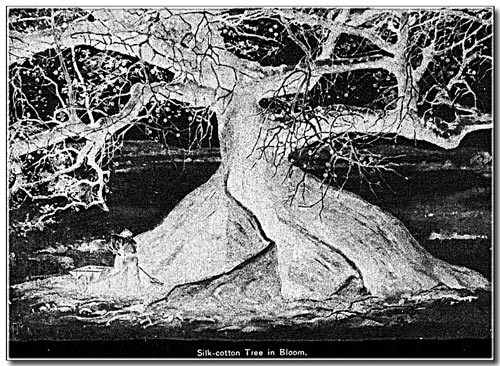Jumbies and Werewolves
(By Robin Swank, with the assistance of several other unnamed ghoulish board members.)
Halloween wasn’t observed in these islands until the U.S. influence began to strengthen in the 1960’s, but there has never been a lack of spirits or hauntings here, with traditions of fright that go back to both Africa and Europe.

Will you see jumbies on St John, come All Hallow’s Eve?
If you have lots of trees, you’re especially likely to spot a spirit. Seeing jumbies at the foot of trees is common. In Remarkable Big Trees of the US Virgin Islands, Robert Nicholls reports a conversation between two friends: “Any tree a jumbie tree come ah night time.” The silk cotton or kapok tree, however, which appears as a spirit tree or kinship shrine in West African stories, merits special mention as a jumbie tree. Cutting down a silk cotton releases spirits that live in the tree, and these homeless spirits will haunt you for years before they settle down again. Also, bats congregate around silk cottons in bloom. And we all know about bats—Count Dracula’s friends? If you’re near a kapok tree during Halloween night, perhaps you‘ll see it pelted with eggs and chickens in order to ‘catch’ a stolen shadow and put its owner at rest. Jumbies are also likely to persist near burial grounds. If a person is not put to rest properly (perhaps no Nine Night funeral wake? Or his toes are not tied together to keep him from walking?), then that person’s burial plot is a “hot spot’ for meeting a jumbie.
Certain places on St John, such as Denis Bay and Jumbie Bay, were notorious for an abundance of spirits. By the mid 20th century, the ‘enlightenment’ of modern thought had begun to erode traditional beliefs on St. John, but jumbie stories were still widely used to frighten children into better behavior.
What about werewolves?
In an excerpt from his book, recaptured in St John Backtime, Desmond Holdridge describes his St John arrival so: “In the weighing of a strange white man, the first day or two goes by in trying to please him…Should the stranger decide to stay, it is decided that he is a detective, a millionaire or a werewolf.” According to additional authoritative texts consulted, werewolves were always European; many local anti-werewolf remedies, such as garlic hung over doors and windows, came straight from Europe as well.
You can easily identify a werewolf by his physical characteristics…..or perhaps by the furniture in his house. Heed this description from J. Antonio Jarvis’ The Virgin Islands and Their People: “The werewolf is described as a large-headed heavy quadruped about the size of a sheep, very fleet and nimble, since it can climb house roofs, vault over fences and scamper faster than the average dog. It is supposed to be a Dane or a German who has divested his humanity in a Jekyll-Hyde transformation by using drugs, incantations and a number of backward somersaults over a four legged stool.”
Hamilton Cochran’s These Are the Virgin Islands relates: “From St John comes a curious tale about a were-wolf, the truth of which cannot be gainsaid.” He identifies the supposed werewolf as Henry Jordon, a ‘gaunt’ engraver or ‘etcher’ who lived a secluded life in a cottage near Trunk Bay. Reticent, quietly tending his bees, liking walks in the moonlight, he was suspected of being a werewolf. While walking home one night a huge commotion on the path ahead made him pause. A small donkey, that could indeed sound and seem like a 4-footed werewolf in the dark, had been attacked in his stead. The ‘real’ Henry Jordon was most likely Wilbur Davis, who, Rafe Boulon and his cousin Erva report, was an engraver who lived in a 1929 cabin near the beach, at the base of the hill going up to Trunk Bay house. If we are to believe Mr. Cochran, this house was burned to rid the area of that pesky werewolf; Rafe maintains it was termites.
So if you are in search of jumbies and werewolves on Hallow E’en, you now know what to look for!
If you’d rather avoid jumbies and werewolves, then lock your dog and donkey up tight, hang bapoos (jumbies in a bottle) in your trees, put an obeah lamp (or jack o’ lantern) under your bed; throw 99 gains of corn or barley on your doorstep (the werewolf will search interminably for the 100th), play Michael Jackson’s Thriller very loud, chalk ‘Only Goblins under ten years old welcome” on your door, and either wear a hat or stay inside until dawn breaks.
See the related items:
[Way of life]

